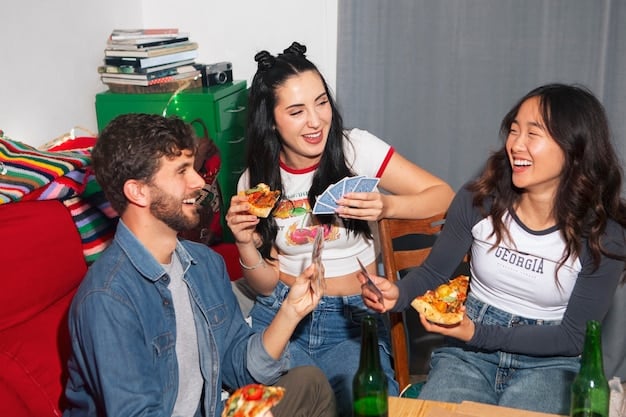The Evolution of the Sitcom: Decades of Laughter and Influence

The sitcom, a cornerstone of television, has mirrored societal shifts and technological advancements since its inception, evolving from simple domestic narratives to complex, character-driven ensembles, continuously redefining humor and storytelling in a compact, episodic format.
Few genres have shaped the landscape of television and reflected societal shifts as profoundly as the sitcom. From its humble beginnings to its current diverse forms, the evolution of the sitcom: tracing the genre’s development through the decades offers a fascinating journey through cultural changes, comedic innovations, and technological advancements. This article delves into the transformative journey of this beloved format, exploring how it has consistently managed to entertain, provoke thought, and remain relevant across generations, making it a persistent and powerful force in entertainment.
The Dawn of Domestic Bliss: Sitcoms in the 1950s and 60s
The post-World War II era ushered in an age of prosperity and suburbanization, profoundly influencing early television programming. Sitcoms of the 1950s and 1960s largely mirrored this societal landscape, presenting an idealized vision of domestic life, centered around wholesome families and their everyday comical predicaments.
These shows served as a comforting reflection of the American dream, offering predictable narratives and moralistic undertones. The humor often stemmed from misunderstandings, lighthearted mischief, and the inherent quirks of family dynamics, providing a much-needed escape from the complexities of a changing world.
Pioneering Formats and Iconic Characters
This period was characterized by the establishment of foundational sitcom structures, many of which remain influential today. The live studio audience, for instance, became a staple, providing immediate feedback and contributing to the authentic, theatrical feel of the productions. Characters, though often archetypal, quickly became household names, embodying aspirational values or lovable flaws.
- I Love Lucy (1951-1957): Starring Lucille Ball as the vivacious Lucy Ricardo, this show was revolutionary for its use of multicamera production and the sheer comedic genius of Ball and Desi Arnaz. It often broke from conventional domestic scenes, featuring Lucy’s outlandish schemes to break into show business, yet always grounded in the love and exasperation of her marriage. Its immediate popularity set the standard for the genre.
- Leave It to Beaver (1957-1963): A quintessential portrayal of suburban 1950s family life, following the misadventures of young Theodore “Beaver” Cleaver. This series emphasized traditional family values and lessons learned, with parents Ward and June Cleaver serving as wise, unwavering figures.
- The Dick Van Dyke Show (1961-1966): A more sophisticated take on domestic and professional life, centered on television writer Rob Petrie. This show offered sharp writing, witty dialogue, and showcased the evolving dynamics within both a family and a workplace, blending physical comedy with clever situational humor.
While these shows presented a largely homogeneous view of American life, they were masterclasses in character development and comedic timing. Their influence extended beyond entertainment, shaping perceptions of family structure and gender roles, albeit often through a conformist lens. The era also saw the rise of fantasy sitcoms, such as “Bewitched” and “I Dream of Jeannie,” which injected magical realism into domestic settings, offering a playful escape from reality.
The comedy, while generally benign, occasionally touched upon subtle social commentary, but largely adhered to the prevailing conservative attitudes of the time. This period solidified the sitcom as a reliable source of entertainment and comfort, laying the groundwork for the genre’s continued expansion and diversification in subsequent decades.
Challenging Conventions: Sitcoms in the 1970s and 80s
As the cultural landscape became more tumultuous in the 1970s, sitcoms began to shed their veneer of domestic perfection, daring to tackle more complex and often controversial social issues. This era marked a significant departure from the idealistic portrayal of family life, embracing grittier realities and diverse perspectives.
The 1980s continued this trend, albeit with a renewed focus on aspirational wealth and career success, while still maintaining an undercurrent of social awareness. The humor evolved, becoming more pointed, and sometimes even satirical, reflecting a society grappling with rapid change.
Social Commentary and Character Development
The 1970s, in particular, saw a surge in “relevance” sitcoms, shows that used humor to explore pressing societal concerns like prejudice, poverty, war, and class struggles. This shift was largely helmed by producers like Norman Lear, who believed television had a responsibility to reflect and engage with contemporary issues. The characters, while still comedic, gained more depth and nuance, making them relatable in their imperfections. These shows sparked national conversations and subtly influenced public opinion.
- All in the Family (1971-1979): This groundbreaking series centered on Archie Bunker, a bigoted, working-class patriarch, and his liberal family. Through sharp, often uncomfortable dialogue, it directly confronted racism, sexism, and generational divides, forcing viewers to confront their own biases.
- M*A*S*H (1972-1983): Set during the Korean War, this sitcom combined humor with the grim realities of war. Its dark comedy and anti-war sentiments resonated deeply with audiences during the Vietnam War era. It masterfully blended comedic moments with poignant, dramatic scenes, pushing the boundaries of the sitcom format.
- The Cosby Show (1984-1992): A cultural phenomenon of the 1980s, portraying an affluent African-American family, the Huxtables. It became a ratings juggernaut by focusing on family dynamics, education, and positive role models, largely avoiding overt social issues but strongly promoting positive values and a nuanced portrayal of Black family life.
The 1980s brought a different kind of evolution, moving towards a more polished, upscale aesthetic, often reflecting the decade’s economic boom. While still socially conscious, shows like “Family Ties” and “Cheers” emphasized character-driven narratives and ensemble casts, creating intimate relationships that viewers cherished. These shows refined the art of the multi-camera sitcom, proving that complex character arcs and ongoing storylines could thrive within the episodic structure.
The progression in these two decades was pivotal. Sitcoms transformed from simple escapism to powerful cultural mirrors, capable of both making people laugh and initiating profound public discourse. They demonstrated the genre’s inherent flexibility and its capacity for growth, setting the stage for even more experimental and diverse forms of comedy to emerge.

The Rise of Ensemble Casts and Urban Living: Sitcoms in the 1990s
The 1990s represented a golden age for the sitcom, characterized by a shift from traditional family dynamics to the “chosen family” of friends and colleagues living in urban settings. This decade showcased sophisticated writing, complex character development, and a keen understanding of ensemble chemistry, fundamentally reshaping the comedic landscape.
The humor often derived from the mundane absurdities of everyday life, relationship woes, and career struggles, all filtered through the unique personalities of tightly knit groups. The prevalence of shows set in New York City and other major metropolitan areas reflected a growing cultural fascination with urban experiences and the nuances of young adult life.
Defining the ‘Friends’ and ‘Seinfeld’ Eras
Two shows, “Friends” and “Seinfeld,” became the undeniable titans of 90s sitcoms, each embodying a different facet of the decade’s comedic sensibility. While “Friends” celebrated the warmth of camaraderie, “Seinfeld” famously embraced the “show about nothing,” finding humor in the minutiae of daily existence.
- Friends (1994-2004): This beloved series chronicled the lives of six young adults navigating love, careers, and friendship in New York City. Its charm lay in its relatable characters, their evolving relationships, and a perfect blend of witty dialogue, physical comedy, and heartfelt moments. “Friends” cemented the idea of the chosen family as a central theme in sitcoms and became a global cultural phenomenon.
- Seinfeld (1989-1998): Famously described as a “show about nothing,” “Seinfeld” redefined observational humor. It focused on the petty annoyances and social faux pas of everyday life, seen through the cynical lens of Jerry Seinfeld and his eccentric friends. The show’s sharp writing, intricate plotlines that often converged comically, and iconic catchphrases made it a critical and commercial success, pioneering a new brand of self-aware, meta-comedy.
- Frasier (1993-2004): A critically acclaimed spin-off of “Cheers,” “Frasier” distinguished itself with its sophisticated humor, witty banter, and exploration of upper-crust intellectualism alongside relatable family dynamics. It proved that sitcoms could be both highly intelligent and broadly appealing.
Beyond these giants, the 90s also saw a diversification of sitcom themes, from the working-class families of “Roseanne” to the suburban whimsy of “Home Improvement.” The decade experimented with different comedic styles, including the burgeoning mockumentary format (though not yet fully realized as a dominant style), and explored a wider range of character types. The move towards more intricate character arcs and less reliance on episodic resets became common, fostering deeper audience investment.
The 1990s cemented the sitcom’s status as a dominant cultural force, proving its adaptability and its ability to capture the zeitgeist of a rapidly changing world. The focus on character-driven narratives and the exploration of modern relationships set the stage for even greater innovation in the new millennium.
Mockumentaries and Single-Camera Shifts: Sitcoms in the 2000s
The 2000s ushered in a significant stylistic shift in the sitcom genre, moving away from the traditional multi-camera, laugh-track format towards the single-camera, mockumentary style. This change allowed for more nuanced character expressions, greater narrative flexibility, and a more naturalistic comedic tone, drawing viewers deeper into the worlds of the characters.
The decade witnessed a surge of creativity, as writers and producers experimented with new storytelling techniques and pushed the boundaries of what a sitcom could be. The humor became less about punchlines and more about awkward situations, character quirks, and the absurdity of everyday life, often delivered with a dry wit.
Innovating Formats and Comedic Styles
The single-camera setup, previously more common in dramas, enabled a different approach to filming, offering greater freedom in set design, camera work, and editing. This, combined with the mockumentary style, which simulates a documentary crew following characters, lent an air of realism and intimacy to the shows, making the humor feel more organic.
- The Office (US) (2005-2013): A masterful adaptation of the British original, this mockumentary-style sitcom perfected the art of cringe comedy. Set in a paper company, it explored the awkwardness of office life, the quirks of its employees, and the surprisingly poignant relationships that blossomed amidst the mundane. Its use of direct-to-camera confessionals allowed for deep character insight and enhanced the realism.
- Arrested Development (2003-2006, 2013-2019): Renowned for its intricate plotting, dense comedic layering, and rapid-fire jokes, “Arrested Development” was a critical darling that pushed the boundaries of sitcom humor. Its ensemble cast and chaotic family dynamics, told through a single-camera, often fourth-wall-breaking style, made it a unique and highly influential series, despite its initial lower ratings.
- Parks and Recreation (2009-2015): Starting as a spiritual successor to “The Office,” “Parks and Recreation” quickly found its own voice, evolving into a heartwarming yet hilarious mockumentary about civil servants in a small-town government department. It celebrated optimism, community, and the power of teamwork, contrasting with the often more cynical tone of its mockumentary predecessors.
The 2000s also quietly continued the multi-camera tradition with hits like “Two and a Half Men” and “The Big Bang Theory,” demonstrating that while new formats emerged, the classic sitcom structure still had a place. However, the influence of the single-camera and mockumentary styles truly redefined the genre’s aesthetic. These shows excelled at finding humor in the discomfort of human interaction and the everyday struggles of relatable characters, moving away from broad, generic humor towards more specific, character-driven comedy.
This decade marked a pivotal moment in the sitcom’s evolution, demonstrating a willingness to experiment with form and content. The success of these innovative shows proved that audiences were ready for a more sophisticated, often less conventional, brand of humor, setting the stage for the genre’s continued diversification in the subsequent decades.
Streaming, Niche Audiences, and Darker Humor: Sitcoms in the 2010s to Present
The 2010s to the present day have witnessed an unprecedented explosion in the diversity and stylistic range of sitcoms, largely driven by the rise of streaming platforms. This era has moved beyond traditional network constraints, allowing for greater creative freedom, more niche storytelling, and a deeper exploration of complex themes, often infused with darker or more observational humor.
The definition of a sitcom itself has expanded, with shows blending traditional comedic elements with dramatic intensity, moral dilemmas, and even philosophical introspection. This period is characterized by innovation, a challenging of genre boundaries, and a responsiveness to diverse audience appetites.
Beyond the Laugh Track: The New Wave of Comedy
Streaming services like Netflix, Hulu, Amazon Prime Video, and later HBO Max and Apple TV+ offered unprecedented opportunities for showrunners to experiment with episode length, season structure, and content that might be too edgy or unconventional for traditional broadcast television. This led to a flourishing of unique voices and narrative approaches.
- Atlanta (2016-2022): Created by Donald Glover, “Atlanta” defies easy categorization, blending surrealism, social commentary, dark comedy, and profound dramatic moments. It offers a unique and often unsettling look at race, class, and the music industry in Atlanta, pushing the boundaries of what a “comedy” series can be.
- Fleabag (2016-2019): A British sensation, “Fleabag” (created by and starring Phoebe Waller-Bridge) redefined the dark comedy-drama. It is sharply witty, emotionally raw, and features a protagonist who frequently breaks the fourth wall to address the audience. Its vulnerability, cynicism, and exploration of grief and relationships resonated deeply with viewers, proving that humor can coexist with profound sadness.
- The Good Place (2016-2020): This show combined high-concept philosophical exploration with brilliant comedic writing. It followed a group of deceased individuals mistakenly sent to a utopian afterlife, forcing them to confront ethical dilemmas and the meaning of goodness. Its intricate plotting, unexpected twists, and delightful ensemble cast made it a critical darling.
- Ted Lasso (2020-Present): A beacon of optimism in often cynical times, “Ted Lasso” (Apple TV+) became a global hit for its heartwarming storytelling, intelligent humor, and focus on kindness and mental health. While still episodic, it leans heavily into character development and overarching dramatic arcs, reminding viewers of the power of genuine human connection and positive leadership.
This contemporary era also sees sitcoms embracing more diverse casts and storylines that reflect the true complexity of modern society. From shows like “Black-ish” tackling racial issues within a multi-generational family, to “Schitt’s Creek” celebrating acceptance and family transformation, the genre continues to evolve as a mirror of human experience. The advent of concise, binge-watchable seasons means narratives can be more serialized, allowing for deeper character dives and more ambitious storytelling. The humor is often less reliant on overt jokes and more on character-driven situations, subtle observations, and a willingness to explore uncomfortable truths, making for a richer, more engaging viewing experience.
The current landscape of sitcoms is incredibly rich and varied, demonstrating the genre’s enduring appeal and its remarkable capacity for reinvention. It continues to be a potent medium for laughter, but also for poignant reflection and societal commentary, adapting seamlessly to new platforms and audience expectations.
Cultural Impact and Enduring Legacy of Sitcoms
Beyond providing endless entertainment, sitcoms have played a profound role in shaping cultural conversations, reflecting societal norms, and even subtly influencing public opinion. They are more than just comedies; they are cultural artifacts that capture the essence of different eras, offering insights into evolving relationships, social issues, and even technological advancements. Their enduring legacy lies in their ability to resonate across generations and continue to influence new forms of storytelling.
Sitcoms as Social Barometers and Trendsetters
Sitcoms have consistently served as a barometer for societal change, mirroring shifts in family structures, gender roles, and ethical considerations. From the idealized family units of the 1950s to the more complex, diverse portrayals of today, the genre has adapted to showcase a broader range of human experiences. The humor itself evolves, reflecting changes in social sensibilities and comedic tastes. What was considered funny or acceptable in one decade might be viewed differently in another, making sitcoms a fascinating lens through which to examine cultural progression.
- Shaping Language and Pop Culture: Iconic catchphrases (“Did I do that?”, “How you doin’?”, “No soup for you!”) and character archetypes from sitcoms have deeply infiltrated everyday language and pop culture reference points. They become shared cultural touchstones that foster a sense of collective identity and nostalgia.
- Normalizing Issues and Sparking Dialogue: Early sitcoms might have shied away from controversy, but later series boldly tackled topics such as racism, class disparity, LGBTQ+ rights, mental health, and single parenthood. By presenting these issues within a comedic framework, sitcoms can make complex subjects more accessible, fostering understanding and encouraging public discourse. “Will & Grace,” for instance, was lauded for its role in bringing gay characters into mainstream living rooms, contributing to greater acceptance and visibility.
- Influencing Fashion and Lifestyles: The apartments of “Friends,” the clothing styles on “That ’70s Show,” or the aspirational lives in “Sex and the City” have often set trends in interior design, fashion, and lifestyle choices. Sitcoms present idealized (or hilariously messy) versions of life that capture the collective imagination.
The impact of sitcoms extends beyond simple entertainment. They provide comfort in times of uncertainty, allow us to laugh at ourselves, and encourage empathy by presenting diverse perspectives. The format’s adaptability, from its early live broadcasts to multi-camera studio productions and now the single-camera, cinematic styles prevalent on streaming platforms, ensures its continued relevance.
As technology evolves and societal norms continue to shift, so too will the sitcom. Its journey through the decades is a testament to its flexibility, its capacity for reinvention, and its deep connection to the human experience. The enduring legacy of the sitcom is cemented in its pervasive influence on comedy, storytelling, and its unique ability to capture the laughter, trials, and triumphs of life, one episode at a time.
In conclusion, the evolution of the sitcom is a dynamic narrative, weaving through eras of rigid conformity to periods of bold experimentation. It highlights an entertainment format uniquely capable of reflecting and influencing societal change while consistently entertaining audiences worldwide. The genre’s adaptability and enduring appeal ensure its place as a cornerstone of television history and a continuous source of joy and reflection.
| Key Milestones | Brief Description |
|---|---|
| 📺 Early Family Norms | 1950s/60s focused on idealized domestic life and wholesome family values (e.g., I Love Lucy). |
| 🗣️ Social Commentary | 1970s/80s boldly addressed social issues and developed deeper characters (e.g., All in the Family, M*A*S*H). |
| 🏙️ Ensemble & Urban Life | 1990s brought focus on “chosen families” and metropolitan settings (e.g., Friends, Seinfeld). |
| 🎬 Format Innovation | 2000s to present saw single-camera, mockumentary styles and niche streaming content flourish (e.g., The Office, Fleabag). |
Frequently Asked Questions About Sitcom Evolution
▼
A sitcom traditionally refers to a “situational comedy,” a genre featuring recurring characters in a common environment, such as a home or workplace, often with a laugh track. While the core element of humor derived from situations remains, its form has evolved from multi-camera, studio-based productions to single-camera, film-like series, and its themes have broadened significantly from simple domesticity to complex social commentary and character studies.
▼
The mockumentary style gained popularity because it offered a fresh, naturalistic approach to comedy. By simulating a documentary, it allowed for more improvisation, subtle humor, and direct addresses to the camera, creating a sense of realism and intimacy. This format resonated with audiences looking for less artificial, more character-driven humor, diverging from the traditional laugh-track-heavy sitcoms that dominated previous decades.
▼
Streaming platforms have revolutionized the sitcom by removing traditional broadcast constraints. They allow for more creative freedom in terms of content, pacing, and episode length, leading to a surge in diverse and niche comedies. Shows can now explore darker humor, more complex narratives, and serialized storytelling, appealing to specific audiences without needing universal appeal, thus expanding the very definition of what a sitcom can be.
▼
While early sitcoms often presented an idealized, sometimes homogenous, version of society, the genre quickly became a powerful mirror reflecting and influencing societal changes. From the social commentary of 1970s “relevance” sitcoms addressing race and class, to modern shows exploring LGBTQ+ rights and mental health, sitcoms have consistently adapted to incorporate evolving social norms, political climates, and cultural shifts, serving as comedic barometers of their times.
▼
The enduring popularity of sitcoms stems from their relatability, humor, and ability to provide escapism and comfort. They often address universal human experiences like family, friendship, and work challenges in a humorous way. Moreover, the genre’s adaptability, its willingness to evolve with cultural shifts, embrace new comedic styles, and leverage technological advancements (from live TV to streaming), has ensured its continuous appeal across diverse generations and changing audience preferences.
Conclusion
The journey of the sitcom, from its idealized domestic beginnings to its current multifaceted forms, is a testament to its incredible adaptability and enduring power. This genre has not merely entertained; it has consistently reflected, and often shaped, societal norms, cultural conversations, and our collective understanding of the world. As technology advances and audiences evolve, the sitcom continues to reinvent itself, proving its vital role as a comedic lens through which we process the complexities of human existence. Its legacy is rich, its present is dynamic, and its future promises continued innovation and laughter for generations to come.





